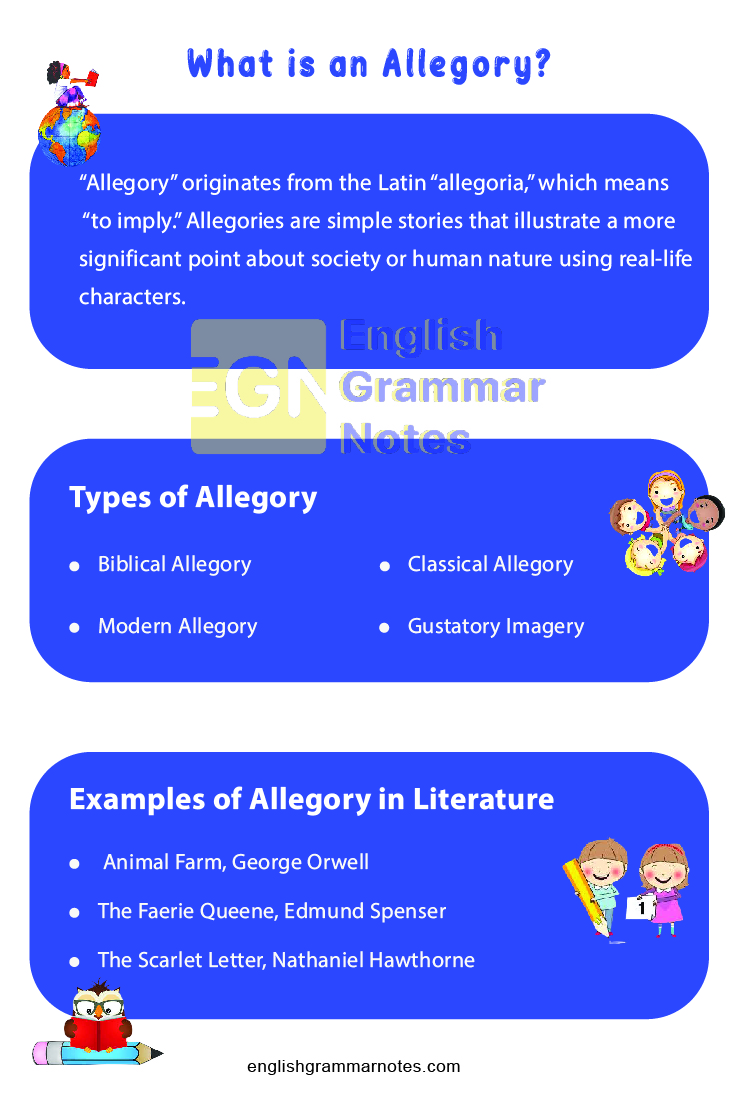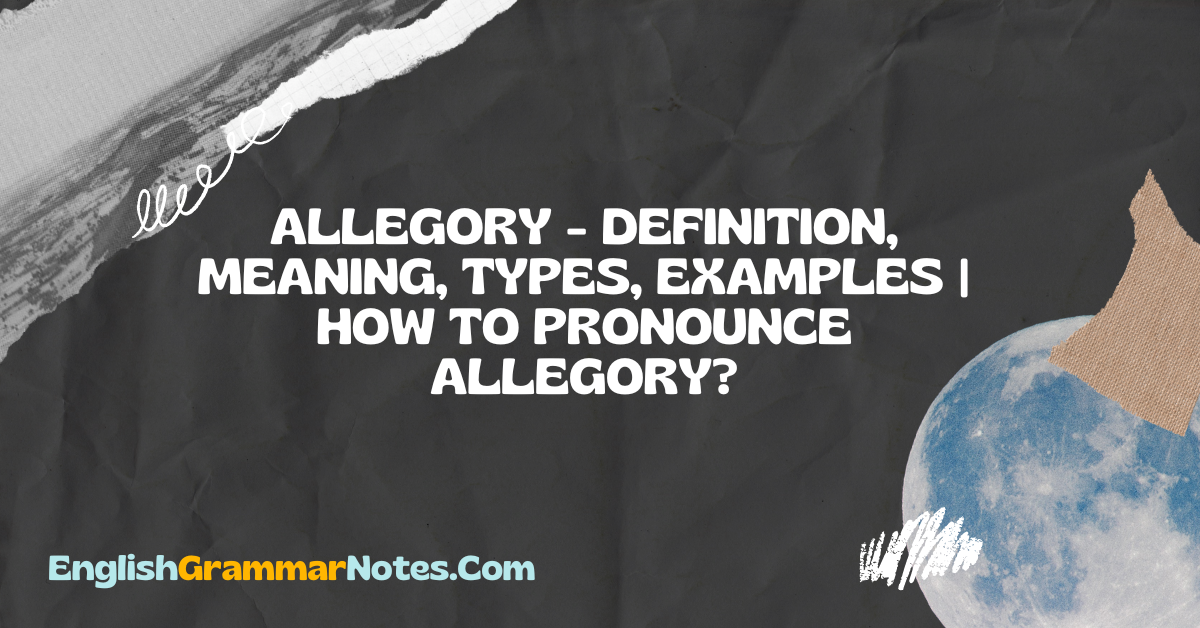An allegory is a story in which events, activities, characters, settings, or objects represent abstract ideas. Literary allegory has two levels. The overt narrative/description should be intriguing and amusing by itself. Allegory emphasizes abstract values symbolized by literary elements. The meaning underlying the surface narrative is more academic. Not all allegories are didactic, imparting a moral, ethical, or religious message. Go through the entire article to be well versed with information like What is Allegory, Types of Allegory, Examples of Allegory in a Sentence, Tips to use it, etc.
- What is an Allegory?
- Why Write an Allegory?
- Types of Allegory
- Allegory Vs Symbolism
- Allegory Vs Metaphor
- Benefits of using Allegory in Writings
- Examples of Allegory in Literature
- Tips for Writing Allegory
- FAQs on Allegory
What is an Allegory?
“Allegory” originates from the Latin “allegoria,” which means “to imply.” Allegories are simple stories that illustrate a more significant point about society or human nature using real-life characters. Sometimes a tale may repeat events from history or present life without overtly mentioning this. Allegories and metaphors both compare things to demonstrate a concept. Metaphors are brief figures of speech, but allegories are whole stories.
Why Write an Allegory?
Allegory expresses broad, abstract thoughts or comments about society. In Animal Farm by George Orwell, allegory allows the author to discuss complex themes that would be too hazardous to discuss directly.
Types of Allegory
Allegories serve a variety of purposes. The various types of Allegories are
Biblical Allegory: Biblical allegory uses Bible motifs to analyze good vs. evil. C.S. Lewis’ The Chronicles of Narnia uses biblical metaphors. Aslan is a Christ-like character who rules Narnia. Aslan is resurrected after sacrificing himself for Edmund, the Judas figure. Biblical allegory can also refer to Middle Ages allegorical Bible interpretations.
Classical Allegory: Plato’s Allegory of the Cave is a well-known allegory. In this fable, Plato imagines cave dwellers who only see objects as shadows cast by a fire. Plato utilized the cave to contrast reality vs. our understanding of it.
Modern Allegory: Modern allegory includes several examples of “allegoresis,” the understanding of works as allegorical without their intention. Readers dispute whether J.R.R. Tolkien’s Lord of the Rings was an allegory for World War I.
Allegory Vs Symbolism
Allegory and symbolism are often confused. Symbolism uses words, characters, locations, or abstract ideas to signify anything beyond their literal meaning. Allegories use symbolism to convey moral or more profound importance to the reader. In the allegory, practically all narrative aspects have symbolic meanings that enhance the story’s significance. Allegory uses symbolism to convey more profound meaning.
Allegory depends on symbolism, yet symbols alone don’t make a literary work an allegory. An allegory is a story in which practically every element, including characters and plot, symbolizes something else, or the story itself symbolizes a more extensive concept or historical event. Symbolism is vital to allegory, but it’s present in other literary works.
Read More:
Allegory Vs Metaphor
Allegory and metaphor are different, despite appearances. A metaphor is a minor figure of speech, unlike an allegory. Allegories show parallels in human existence on a larger scale than metaphors, usually one sentence. An allegory teaches a moral lesson, but a metaphor does not. A metaphor does not become an allegory just because it describes a character in an allegory. It’s a linguistic element of descriptive prose.
Benefits of using Allegory in Writings
The various advantages of Allegories to the writers are given below.
Allows Contentious Topics
Allegory creates distance between writer and subject, allowing sensitive themes to be addressed. The issue of an allegory is symbolic, not literal, which helps readers. Allegory’s symbolism makes it easier for the writer and reader to discuss war, religion, and human nature.
Literary Art
Compelling allegories require literary competence. The surface tale must stand alone, while the symbolic narrative must be accessible and intelligible. Allegory is a literary art.
Help Reader
Some abstract ideas are hard to grasp. Using allegory to explain and demonstrate concepts helps improve reader understanding. This is true for philosophical systems and advanced thinking.
Examples of Allegory in Literature
Allegory is centuries old. Examples of allegories follow.
Animal Farm, George Orwell
Animal Farm is widely used to introduce allegory in high school English classes. In this agricultural story, animals control a faction society that parallels Leon Trotsky and the Russian Revolution. The narrative is a fable about farm animals ruling a community or criticizing communism.
The Faerie Queene, Edmund Spenser
The Faerie Queene was written around 1590. This poem introduced Spenser’s stanza. The poem covers twelve qualities through Arthurian knights. The poem was a criticism of Queen Elizabeth I’s reign. Academics and critics dispute whether the comments are positive or destructive.
The Scarlet Letter, Nathaniel Hawthorne
In Hawthorne’s 1850 book set in the 1600s, Hester Prynne is publicly humiliated after becoming pregnant out of wedlock. The scarlet letter symbolizes sin and society’s punishments. The novel criticizes Puritan hypocrisy.
Aesop’s Fables
These stories are assigned to Aesop, an ancient Greek slave. Frequently addressed to youngsters, these fables offer advice on social, political, and religious matters. Aesop’s Fables teach children how to behave and what to value through metaphor.

Tips for Writing Allegory
You must follow these tips when using Allegories in your writings.
- Decide what you want to tell your reader. It should be huge, complex, and relevant to your civilization.
- Plan your allegory after choosing a theme. Consider how you’ll turn real-world ideas into fictional scenes and characters. Animals are familiar, like Aesop’s Fables and Animal Farm, but there’s no restriction about what to employ.
- Your audience will be attempting to figure out who each character symbolizes in real life, so avoid using unrelated, unclear characters.
- Help your reader read between the lines. It would help if you left clues without overexplaining. Don’t be so subtle readers overlook the allegory.
- The story must be self-contained. This isn’t an essay or a speech, despite the abstract message. The top layer must still be engaging.
FAQs on Allegory
1. What is the difference between Allegory and Metaphor?
Allegory expresses human truths or generalizations through fictional characters’ behavior, including fables and parables. Metaphor is figurative language in which one word or phrase denotes another to convey a likeness or analogy. Allegory is Aesop’s Fables; metaphor is “the ship ploughs the waters.”
2. Which allegories exist?
A fictional character represents a topic or type of personification metaphor. Everyman and the Lover in The Romance of the Rose are personification allegories. Symbolic allegory is when a character or object has a distinct identity apart from the message it represents. Virgil in Dante’s Inferno is a metaphorical, allegorical character embodying human reason.
3. Differentiate between Allegory and Simile?
A simile compares two, unlike objects, frequently using like or as (“he had eyes like agates”). Allegory is a symbolic fictional narrative with hidden meanings. Allegories include parables, myths, and fables.
Conclusion
An allegory is a literary device or artistic genre in which a character, place, or event represents a moral or political meaning. Throughout history, authors have used allegory to demonstrate or transmit complicated ideas and concepts intelligibly or stunningly.
Writers and speakers utilize allegories to express (semi-)hidden or complex meanings through symbolic characters, actions, imagery, or events. Personification is common in allegories. We believe we’ve clarified allegory’s meaning and usage.
